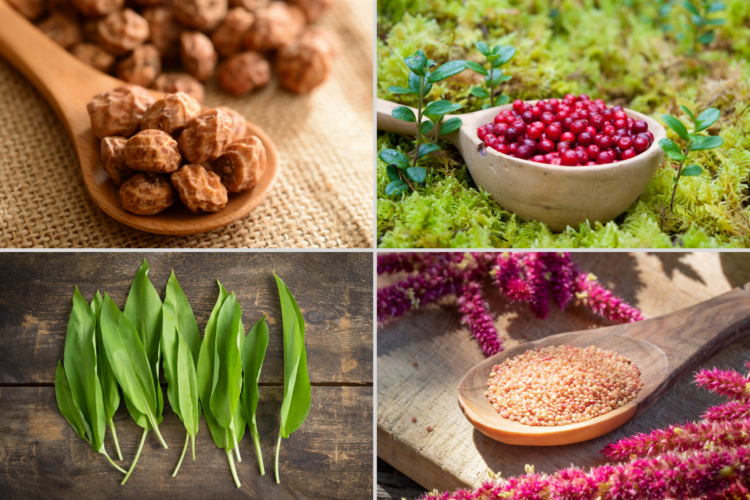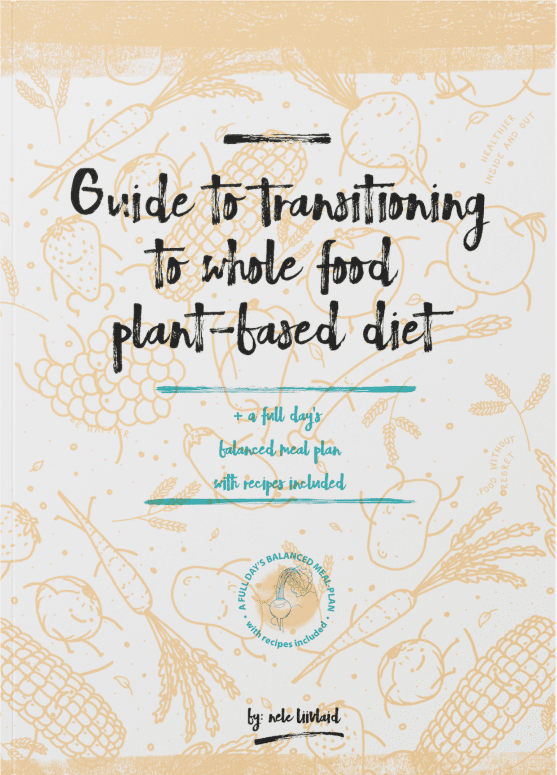Are you eating the same foods over and over? While familiar staples have their place, your body may benefit from trying new things. There are many lesser-known yet nutrient-dense uncommon superfoods that can bring your meals to the next level and support your overall well-being. This guide dives deeper into some powerful, underused ingredients — their benefits, how to use them, and where to find them.
Uncommon Superfoods to Add to Your Diet
Table of contents
- Uncommon Superfoods to Add to Your Diet
- Tigernuts
- Amla Berries (Indian Gooseberries)
- Lingonberries as Uncommon Superfoods
- Goji Berries
- Ancient Grains as Uncommon Superfoods
- Plant-Based Proteins: Pea Protein & Hemp Protein Flour
- Broccoli Sprouts as Uncommon Superfoods
- Nutritional Yeast
- Beet Greens
- Whole Cooked Mature Soybeans
- Spring Foraging Items
- Whole Food Sweeteners as Uncommon Superfoods: Date Flour, Mesquite, Lucuma & Carob
- Final Thoughts on Those Uncommon Superfoods
- Sources:
Tigernuts
Why to consider: Tigernuts are not actually nuts — they’re tubers, making them naturally gluten-free and suitable for nut-free diets. Moreover, they’re rich in resistant starch (a prebiotic fibre), iron, magnesium, potassium, and antioxidants.
Benefits:
- Improve gut microbiome and digestion.
- Support cardiovascular health due to healthy fats.
How to eat:
- Cubes: Toast lightly and sprinkle over porridge or smoothie bowls
- Flour: Use in bliss balls, cookies, and brownies
- Flakes: Great in muesli and baked goods
Where to find: Organic and specialty food stores, or online health food retailers.
Recipe Ideas:
Amla Berries (Indian Gooseberries)
Why to consider: One of the richest natural sources of vitamin C, amla offers potent antioxidant and anti-inflammatory properties.
Benefits:
- Enhances liver detoxification.
- Supports immune function and reduces oxidative stress.
- Good for digestion
- Is often used to stimulate hair growth
- Supports kidney health
How to eat:
- Powder: Add to morning bowls, smoothies, or mix into porridge
Where to find: Organic powders online or at Ayurvedic shops
Recipe Ideas: I’m adding freeze dried amla juice powder to my morning protein bowl.
Lingonberries as Uncommon Superfoods
Why to consider: Tart Nordic berries high in anthocyanins and polyphenols that grow in northern Europe.
Benefits:
- Improve gut microbiota
- May help lower blood sugar spikes
- Promote heart health
- May protect eye health
- High in antioxidants
How to eat:
- Blend into smoothies, add to porridges, or morning bowls
Where to find: Frozen or powdered in specialty and Nordic markets
Goji Berries
Why to consider: A nutrient-dense uncommon superfood with multiple health benefits.
Benefits:
- Rich in zeaxanthin, supports eye health
- Contains melatonin, may enhance sleep
How to eat:
- Soaked in salads, porridge, or as a snack
Where to find: Natural food stores or online
Recipe ideas:
Ancient Grains as Uncommon Superfoods
What to consider: Amaranth and sorghum are gluten-free ancient grains with a high nutritional profile.
Benefits:
- Amaranth: This ancient grain is rich in fibre and protein, as well as many important micronutrients. In particular, it is a good source of manganese, magnesium, phosphorus and iron.
- Sorghum: A nutrient-rich cereal grain. It’s low in fat, but high in protein, fibre, B vitamins, and micronutrients. For example, vitamin B1 (thiamin), vitamin B6, copper, iron, magnesium, phosphorus, potassium, selenium, and zinc.
How to eat:
- Porridges, stews, soups, salads, and as a side
- Sorghum is also great in muffins or breads
Where to find: Organic markets and online grain retailers
Recipe Idea: Sorgum Muffins
Plant-Based Proteins: Pea Protein & Hemp Protein Flour
Why to consider: Additive-free, digestible protein sources.
Benefits:
- Pea protein: High quality protein rich in leucine and iron. Supports muscle growth, weight loss, and heart health.
- Hemp protein: Contains all nine essential amino acids, plus fibre, healthy fats, and minerals. It’s also has an ideal 3:1 ratio of omega-6 to omega-3 fatty acids. Incredibly rich source of minerals such as phosphorus, magnesium, calcium, iron, manganese, zinc and copper.
How to eat:
- Pea protein: Protein bowls, smoothies, bliss balls, and energy bars
- Hemp flour: With plant yogurt, berries, or in baking
Where to find: Organic food shops and online retailers
Recipe Ideas:
- I’m adding both to my morning protein bowl.
- For a wholesome dessert or snack, mix hemp protein flour with plant-based milk/yogurt, add date sugar and some berries.
Broccoli Sprouts as Uncommon Superfoods
Why to consider: One of the richest natural sources of sulforaphane.
Benefits:
- Boosts liver detox enzymes.
- Supports cellular health and antioxidant response.
- Balances hormones.
How to eat:
- On salads, in wraps, sandwiches, or smoothie bowls
To learn more about broccoli sprouts:
- How to Grow Broccoli Sprouts in a Jar.
- Instagram post Broccoli Sprouts: Why Adding Them To Your Diet is Such a Game Changer
Nutritional Yeast
Why to consider: Nutrient-rich, plant-based source of B-vitamins.
Benefits:
- Fortified with B12 for vegans
- Contains beta-glucans to support immune function
How to eat:
- On salads, in soups, hummus, curries, or dressings
Where to find: Supermarkets, natural food stores
Recipe idea: make an easy and delicious dressing mixing nutritional yeast, some miso, and water.
Beet Greens
Why to consider: beet greens are one of the uncommon superfoods that are often overlooked, yet highly nutritious.
Benefits:
- High in vitamin K, calcium, and antioxidants
- May support detoxification and digestive health
How to eat:
- Boil stems 5 mins, add leaves for 1-2 mins, discard water
- Use like any leafy greens
Where to find: Farmer’s markets or grow your own
Whole Cooked Mature Soybeans
Why to consider: High-protein, whole-food soy alternative.
Benefits:
- Contain complete protein and isoflavones for heart and bone health
- Support hormonal balance and metabolic health
How to eat:
- In stews, soups, hummus, salads, oven-roasted for snacks
Where to find: Cook from dry or buy frozen in specialty stores
Recipe Ideas:
Spring Foraging Items
What to consider: Wild garlic, nettle, and ground elder are seasonal uncommon superfoods.
Benefits:
- Nettle: Rich in minerals and chlorophyll, supports energy and detox
- Wild garlic: Natural antimicrobial, supports immune health
- Ground elder: Rich in vitamin E and C containing lots of antioxidants.
How to eat:
- In pestos, stews, soups, and salads
Where to find: Forage responsibly or visit local farmers’ markets
Recipe Ideas:
Whole Food Sweeteners as Uncommon Superfoods: Date Flour, Mesquite, Lucuma & Carob
Date Flour
Why to consider: Whole food sweetener with intact fibre and nutrients.
Benefits:
- Contains potassium, antioxidants, and fibre
- Less processed than other sugars, retains minerals
How to eat:
- In bliss balls, brownies, cookies, sprinkled on porridge or desserts
Where to find: Health stores or online
Recipe Ideas:
- Black Bean Bliss Balls
- Peanut Butter Chocolate Chop Cookies
- Healthy Apple Crumble
- Pumpkin Chocolate Chip Cookies
Mesquite, Lucuma, & Carob
Why to consider: Low-GI natural sweeteners with rich flavour
Benefits:
- Lucuma: High in polyphenols and may help regulate blood sugar
- Mesquite: High in calcium, potassium, and magnesium
- Carob: good source of fibre, calcium, zinc, potassium, phosphorus, vitamin K, riboflavin, vitamin E, and other antioxidants.
How to eat:
- In smoothies, bliss balls, porridges, raw candies, or baking
Where to find: Organic markets, online wellness retailers
Recipe Ideas:
Additional resources to learn more about carob, mesquite, and lucuma:
- The Complete Guide to Carob: Benefits, Uses, and Carob vs Cacao
- 15 Low Glycemic Sweeteners & How to Use Them
Final Thoughts on Those Uncommon Superfoods
Integrating even a few of these foods into your regular meals can help you diversify your nutrition, support optimal health, and keep meals exciting. Nature’s variety is vast — and sometimes the most powerful foods are the ones hiding in plain sight.
Sources:
Should you desire to go deep into each uncommon superfood, check out these articles and studies:
- 6 Emerging Health Benefits of Tiger Nuts
- Indian Gooseberry: Benefits, Uses, and Side Effects
- 14 Impressive Health Benefits of Lingonberries
- What are Goji Berries? This Unique Red Fruit, Explained
- Amaranth: An Ancient Grain With Impressive Health Benefits
- What Is Sorghum? A Unique Grain Reviewed
- Pea Protein Powder: Nutrition, Benefits and Side Effects
- Hemp Protein Powder: The Best Plant-Based Protein?
- Is Nutritional Yeast Healthy? All You Need to Know
- 6 Evidence-Based Benefits of Stinging Nettle
- Nutritive and Bioactive Properties of Mesquite (Prosopis pallida) Flour and Its Technological Performance in Breadmaking
- 6 Surprising Benefits of Lucuma Powder













































